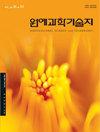番茄绿条纹的遗传定位
IF 0.8
4区 农林科学
Q3 HORTICULTURE
Korean Journal of Horticultural Science & Technology
Pub Date : 2021-06-01
DOI:10.7235/HORT.20210036
引用次数: 0
摘要
番茄(Solanum lycopersicum)果实颜色具有高度的遗传变异,是育种者和消费者所重视的重要果实品质性状。果实条纹的颜色模式是由绿条纹位点决定的,只在番茄的果皮组织中观察到。利用两个不同的F2群体(351和97个个体),我们将gs定位到7号染色体的长臂上,发现它与番茄AGAMOUS-LIKE 1 (TAGL1)共分离。利用tagl1特异性衍生cleaved扩增多态性序列(dCAPS)标记对118个非绿条纹番茄品种和11个绿条纹番茄品种进行关联分析。绿条纹果皮(GSPs)的叶绿素含量高于浅绿色果皮(LGPs),红条纹果皮(rp)的类胡萝卜素含量高于黄条纹果皮(YSPs)。虽然我们没有发现无条纹和有条纹番茄之间TAGL1启动子和编码区的序列差异,但在YSPs中TAGL1的表达量低于RPs。因此,TAGL1的差异表达可能有助于果实条纹图案的形成。利用tagl1特异性标记进行标记辅助选择,将有利于番茄果实条纹图案的选育。附加关键词:类胡萝卜素,叶绿素,DNA标记,果实颜色,TAGL1本文章由计算机程序翻译,如有差异,请以英文原文为准。
Genetic Mapping of green-stripe in Tomato
Tomato (Solanum lycopersicum) has a high level of genetic variation in fruit color, which is an important fruit quality trait considered by breeders and consumers. The fruit stripe color pattern is determined by the green stripe (gs) locus and is observed only in the peel tissue in tomato. Using two different F2 populations (351 and 97 individuals), we mapped gs to the long arm of chromosome 7 and found that it cosegregated with TOMATO AGAMOUS-LIKE 1 (TAGL1). Association analysis using a TAGL1-specific derived cleaved amplified polymorphic sequences (dCAPS) marker distinguished 118 non-green-striped and 11 green-striped tomato cultivars. The chlorophyll content of green-striped peels (GSPs) was higher than that of light-green peels (LGPs), and the carotenoid content of red peels (RPs) was higher than that of yellow-striped peels (YSPs). Although we did not find sequence variation in the promoter and coding regions of TAGL1 between non-striped and striped tomatoes, TAGL1 expression in the YSPs was lower than that in the RPs. Therefore, the differential expression of TAGL1 may contribute to fruit stripe patterning. Marker-assisted selection using the TAGL1specific marker identified here will facilitate breeding of fruit stripe patterning in tomato. Additional key words: carotenoid, chlorophyll, DNA marker, fruit color, TAGL1
求助全文
通过发布文献求助,成功后即可免费获取论文全文。
去求助
来源期刊
CiteScore
2.00
自引率
0.00%
发文量
0
审稿时长
1 months
期刊介绍:
Horticultural Science and Technology (abbr. Hortic. Sci. Technol., herein ‘HST’; ISSN, 1226-8763), one of the two official journals of the Korean Society for Horticultural Science (KSHS), was launched in 1998 to provides scientific and professional publication on technology and sciences of horticultural area. As an international journal, HST is published in English and Korean, bimonthly on the last day of even number months, and indexed in ‘SCIE’, ‘SCOPUS’ and ‘CABI’. The HST is devoted for the publication of technical and academic papers and review articles on such arears as cultivation physiology, protected horticulture, postharvest technology, genetics and breeding, tissue culture and biotechnology, and other related to vegetables, fruit, ornamental, and herbal plants.

 求助内容:
求助内容: 应助结果提醒方式:
应助结果提醒方式:


